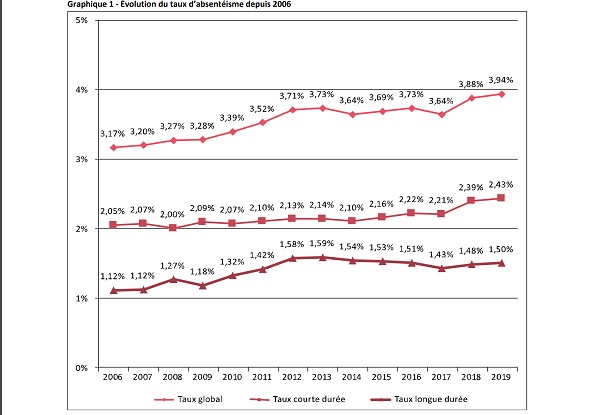 Evolution of the absenteeism rate since 2006;
Credit: MSS
Evolution of the absenteeism rate since 2006;
Credit: MSS
Absenteeism in the workplace has increased by 1.6% over one year, according to statistics published earlier today at a press conference by Luxembourg's Ministry of Social Security.
In the current context of the COVID-19 health crisis, the 2019 absenteeism report was supplemented by an analysis of the situation observed during the first five months of 2020.
From the 2019 assessment, illness-related absenteeism remained relatively stable between 2018 and 2019, with the rate increasing from 3.88% to 3.94% (up 1.6%) over one year. Within that percentage, the number of employees who were absent fell slightly to 55.2% (down from 55.7% in 2018). Employees were absent more often last year than the previous year (average of 2.72 occasions compared to 2.69 in 2018) with an average duration of 7.98 days each (7.97 in 2018).
Both the long-term and short-term absentee rates increased slightly in 2019. The former went from 1.48% to 1.50% (up 1.4%), whilst the latter rose from 2.39% to 2.43% (up 1.7%). This evolution is thus comparable to that observed in 2018 despite the fact that the flu epidemic of the 2018/19 season was less pronounced than the previous one.
At the sectoral level, the 2019 absenteeism rate was between 2.29% (information and communication sectors) and 5.15% (human health and social action sectors). The share of employees who were sick at least once in 2019 varied from 42.2% (administrative and support service activities) to 70.7% (human health and social work). Similarly, the average number of cases of illness varied from 2.31 (accommodation and catering) to 3.43 (private sector employees in the public administration, education sector, whilst the average duration of absences ranged from 4.76 days (financial and insurance activities) to 12.19 days (accommodation and catering).
Concerning the direct cost of absenteeism, which consists of the amount of continued remuneration in the event of illness payable by employers (first thirteen weeks) as well as the sum of financial compensation paid by the National Health Fund (CNS), rose between 2018 and 2019 from €709.3 million to €775.4 million (up 9.3%). Compared to the total compensation of employees, in particular to neutralise the increase in employment as well as that of wages, this cost went from 2.59% to 2.68% (up 3.8%).
The first trends for 2020, and since the start of the COVID-19 health crisis, have shown a sharp increase in the number of days absent from work due to illness (52% in March and 35% in April). This trend is reflected in the monthly change in the rate of employee absenteeism, which peaked at 6.3% in March 2020, before falling to 5.4% in April and then to 3.9% in May, thus reporting a level comparable to that observed in 2019.
More specifically, between March 2019 and March 2020, the employee absenteeism rate increased from 4.2% to 6.3% - an increase of 48%. Given that the comparison over this period makes it possible to capture the effects of the COVID-19 health crisis on sickness absenteeism while minimising the seasonal variations specific to the phenomenon, this 48% increase shows the magnitude of the impact of the crisis on sickness absenteeism in March 2020.








